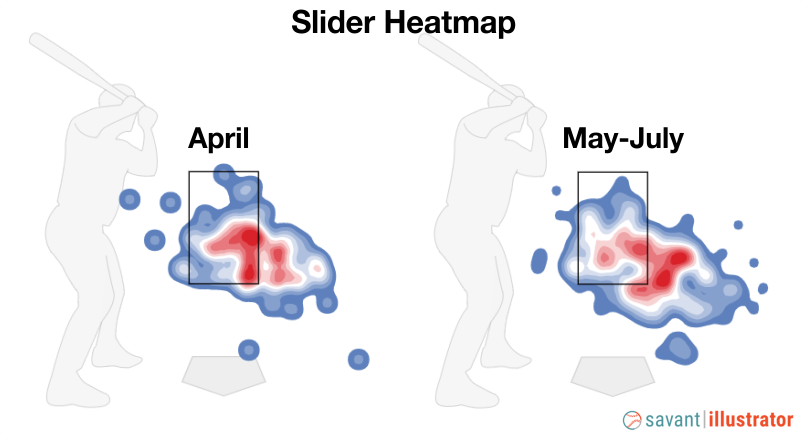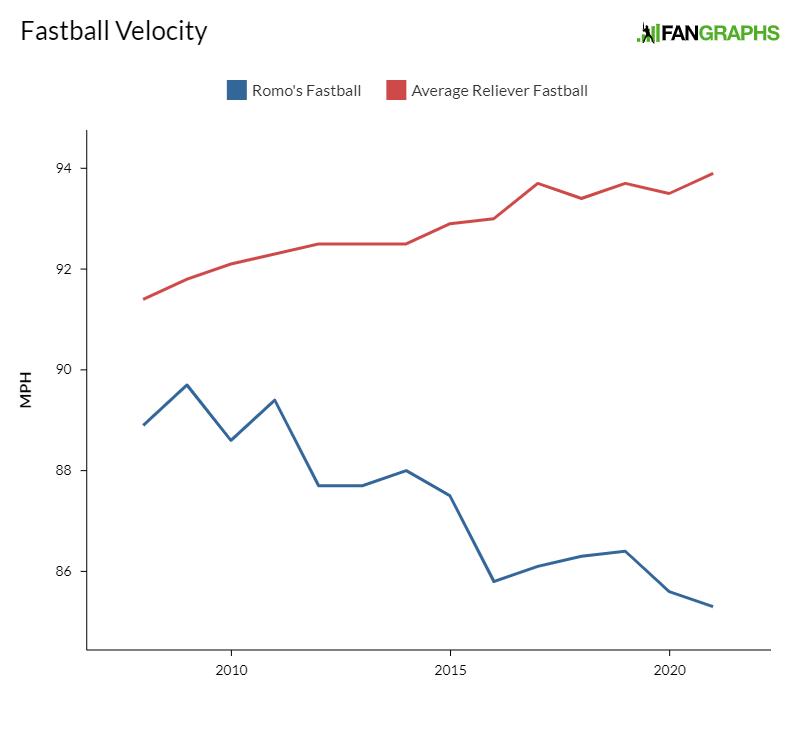How Sergio Romo Uses His Sinker To Set Up His World-Class Slider
With the help of an endearing smile and wipeout slider, Sergio Romo has become a favorite of many a fanbase throughout his long and successful career. Currently with the Oakland A’s, Romo is in his 14th season. At age 38, you would expect any pitcher to be a shell of their former self, yet Romo continues to get hitters out in mostly the same way he always has: sliders, sliders and more sliders. He even has a new wrinkle that might be making his slider even better.
Of course, this season hasn’t gone exactly to plan. Romo got off to quite a rough start; through April he had a 9.35 ERA and 5.70 FIP. He wasn’t getting strikeouts at his usual level (13.3% K-rate) and his dominant slider was uncharacteristically hittable (.370 wOBA). Given his age and the way his 2020 ended (he had a 5.59 FIP in September), you had to wonder whether Romo’s time in the big leagues was drawing to a close. Come May however, he had righted the ship in a big way and since then he’s been the A’s most dominant reliever, posting a 1.88 ERA and 1.83 FIP. Most importantly for fans of his slider, the pitch is back to doing this:
That location off the plate is where Romo likes to live with his slider but he wasn’t able to execute there when he was struggling in April. Take a look at his slider heat maps to righties:

In April, he was leaving a lot of sliders in the strike zone. Now he’s back to throwing more of them off the plate. As a result, the wOBA allowed on his slider since May 1 is a paltry .174. If you are unfamiliar with the uniqueness of Romo’s slider, he’s able to throw the pitch without the characteristic red dot that appears to the hitter because of the way the ball spins. Eno Sarris chronicled Romo’s “no-dot” slider back in 2015. That spin makes it harder for hitters to identify the pitch and leads to some mighty big whiffs.
For most of his prime, Romo has thrown his slider over 50% of the time — to righties it’s about 65%. That kind of usage is more common now as more and more pitchers, relievers especially, are just throwing their best pitch as often as possible. Back in 2011, when Romo broke out with an absurd 0.96 FIP, he threw his slider 54.1% of the time — a large jump from the first few years of his career. Since then he’s basically kept his slider usage around there or higher. It’s clearly his bread and butter and he’ll use it in any count: even in 2-0 counts he uses it over 60% of the time.
Romo offsets his heavy slider usage with a fastball and changeup (mostly used against lefties) that have always been viewed as afterthoughts. Just ask Miguel Cabrera what pitch he was expecting when he stared at a fastball right down the middle to end the 2012 World Series.
The lack of velocity on Romo’s fastball has always made him an interesting pitcher to watch. In an era where seemingly every bullpen arm throws in the high 90s, Romo has continued to get by with much, much less than that. Forget the upper 90s, Romo hasn’t even touched 90 mph since 2014. These days his heater sits around 85 mph and it’s showing no signs up speeding back up. Look how Romo’s velocity loss over the years compares to the velocity increases other reliever fastballs have seen seen on a league-wide scale.

Aside from continued velocity loss, Romo has made a tweak to the way he’s using his fastball. The “Miguel Cabrera take” is happening more and more in 2021 and it’s the result of a slight change in Romo’s pitch mix. Where before his overall fastball usage was made up of a mix between four-seamers and sinkers, this season Romo has completely ditched his four-seam fastball. His sinker now makes up 31.7% of his overall pitch mix — the highest sinker usage of his career. The change in fastball usage makes sense as his sinker is returning a positive run value for the second straight year, while his four-seamer has not provided a positive value since 2017.
| Romo’s Sinker | League Average Sinker | |
|---|---|---|
| CStr% | 27.3% | 20.9% |
| SwStr% | 10.4% | 7.1% |
| CSW% | 37.7% | 28.0% |
When it comes to whiffs (SwStr%), his sinker is well above average but the Called Strike Rate (CStr%) is where it really shines. More than a quarter of the sinkers he throws get taken for called strikes. The previous career high for his sinker was 20.4% in 2019. How is he getting big league hitters to stare at an 85 mph fastball?
The first thing to notice about his sinker is the movement profile. It moves a lot, with well above average drop and horizontal movement. Part of that is simply the lack of velocity — it’s hard to throw straight when you throw slow (you can take my word on that). The dramatic movement isn’t entirely the result of velocity, though, because his sinker has always had about the same velocity as his four-seamer yet the sinker moves quite a bit more. In fact, the movement pretty closely resembles a mirrored version of his slider.
On top of using the pitch more this year, he’s also started to take better advantage of the movement on his sinker. Instead of throwing it in the strike zone and hoping the movement keeps it off the hitter’s barrel, he’s now throwing it off of the outside corner and having the movement work the pitch back into the strike zone. Look at his sinker locations to righties this year and then compare that to the locations of his sinkers in his previous four seasons (about the same number of the total sinkers).

Romo is working the ball off the plate much more often. Essentially this pitch has gone from something he hopes hitters swing at to a pitch he hopes hitters watch. The movement brings the ball back to the hitter but by then they’ve already decided to take the pitch. That’s how you get a pitch to give you a higher Called Strike Rate than at any other time in your career.
Remember the slider you saw earlier to Michael Chavis? I want to return to that pitch and take a closer look at the whole at-bat. You may have seen that pitch and wondered why Chavis was even swinging at a pitch so far outside. Sure, the movement was nasty but it seemed to have started well off the plate and broke into the on deck circle. In other words, it never looked like a strike. That’s exactly where the sinker comes in. The reason Romo was ahead in a 0-2 count was because the previous two pitches were sinkers that Chavis took for strikes. Check out those two sinkers.
Generous call on the second sinker aside, both of these pitches set the hitter’s eyeline off the plate and condition him to movement that darts back to the strike zone. Chavis is in an 0-2 hole and all he’s seen are pitches that start off the plate and come back for strikes. Romo clearly has him set up to be absolutely bamboozled by a slider and that’s exactly what happens. Now you can watch the slider again but I’ve blended the 0-1 sinker on top of it so you can see how well the movements mirror each other.
That GIF encapsulates the beauty of Sergio Romo’s sinker/slider combo, and of pitch mirroring in general. Halfway to the plate those pitches are in the same spot and then they end up a catcher’s arm length apart. If you’re sturdy enough to take the slider, it means you’re probably vulnerable to the sinker; if you’re geared up for the backdoor sinker, you’re about to look foolish when you get a slider.
I don’t know how hitters do it.
Luke Hooper is a designer and writer at FanGraphs. He lives in Portland, Oregon, longing for a major league team to materialize.

Some filthy movement on those pitches. Romo’s been a rock post his disaster April.